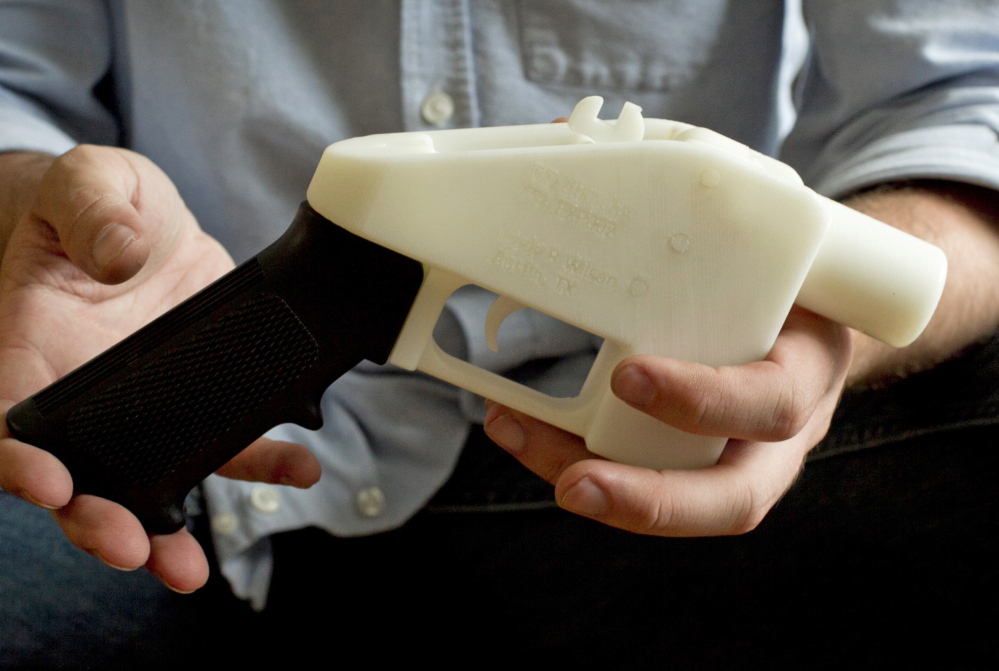Undetectable plastic handguns can be produced with equipment readily available in Maine, but law enforcement officials here and around the country say such weapons have yet to become a serious threat to public safety.
On Monday, Congress renewed a 10-year federal ban on undetectable firearms, including 3D-printed guns made entirely of plastic. Representatives of local, state and federal law enforcement agencies said 3D-printed guns are still crude and unreliable, but the relatively new consumer technology that can produce a working plastic gun at home is expected to get better and cheaper in coming years.
Officials said they were not aware of any arrests in Maine or elsewhere for illegal use or possession of 3D-printed guns, but because such weapons can pass unseen through a metal detector, “they definitely pose a threat to our nation’s airports” and other locations, said Debra Seifert, spokeswoman for the Bureau of Alcohol, Tobacco, Firearms and Explosives in Boston.
Seifert said 3D-printed guns also pose a danger to the people who try to use them, because they could explode when the trigger is pulled.
For that reason, the ATF considers 3D-printed guns more of a potential problem for the future, Seifert said, although she acknowledged that there is no simple way to stop people from making them now.
There are at least 200 3D printers in Maine that are capable of producing a working gun, said Sarah Boisvert, owner of a digital design and fabrication firm in Rockport, 3DMicroFactory, and an organizer of the nonprofit 3D-printing center Maine FabLab.
Boisvert estimated that 10 percent of Maine’s 1,800 manufacturers use 3D printers, along with at least 30 schools.
It’s impossible to say how many individuals in the state own 3D printers, she said, but she suspects that it’s a relatively low number.
Police in Portland have never seen anyone with a 3D-printed gun, said Assistant Police Chief Vern Malloch. And Maine State Police spokesman Stephen McCausland said he was not aware of a single arrest in the state for illegal use or possession of a plastic, 3D-printed gun. In fact, no such arrest has been made worldwide, according to media reports.
Plastic weapons of one kind or another have existed for decades, and are illegal unless they contain enough metal to be detected with a standard metal detector. Seifert said the ATF’s concern is that plastic guns are becoming easier and cheaper to make as 3D printing becomes more ubiquitous. “What’s changed is the technology,” she said.
Authorities in Europe, which has stricter gun-control laws than the U.S., have said they fear that the advent of consumer 3D-printing technology will make it easier to obtain a usable deadly weapon.
Police in Manchester, England, raided a man’s home in October and seized what they believed to be parts for a 3D-printed gun. The items turned out to be plastic replacement parts for the man’s 3D printer.
Three-dimensional printing, also called additive manufacturing, involves special printers that can construct a solid, three-dimensional object from a digital design.
Despite the recent introduction of 3D printers priced as low as $300, experts said a higher-end printer is needed to produce a usable plastic gun. Such printers generally cost $1,000 to $5,000, and can sell for much more at the very high end.
The design for a gun can be obtained for free through peer-to-peer file-sharing services such as BitTorrent. Earlier this year, a law student in Texas posted directions online for making a 3D-printed handgun. A designer in Canada recently released a design for a 3D-printed rifle.
Greg Comcowich, spokesman for the FBI’s Boston field office, said it’s difficult to understand how an all-plastic gun could even be put to practical use. Plastic doesn’t hold up well to the explosive force of a bullet being fired, he said.
“Our Glocks (handguns) are made out of a high-grade polymer plastic, but the barrel is made of metal,” he said.
Law enforcement officials in the U.S. and Europe say they have tested 3D-printed guns after downloading design files from the Internet, and have fired multiple shots from single guns. However, each shot damaged the barrel of the gun, which had to be replaced between firings.
The ban on undetectable guns that Congress renewed Monday has been in force since the Reagan administration, long before the advent of 3D printing, and was due to expire the next day. The Republican-led House approved the extension last week, and President Obama signed the bill late Monday.
The National Rifle Association, which has helped scuttle proposals for tougher firearms restrictions this year, did not oppose the decade-long extension, The Associated Press reported. It did oppose an effort by Sen. Chuck Schumer, D-N.Y., and other Democrats to strengthen the law by requiring that any plastic firearm include a detectable metal component that cannot be removed. Senate Republicans defeated that proposal.
Some plastic firearms technically comply with the quarter-century-old law by containing a detachable metal part, but the part can be slipped off to evade airport security. Democrats said the stricter language is needed in an era when improved and increasingly accessible 3D printers can produce functioning guns.
Democrats who support tightening the rules said the 10-year renewal helps the gun lobby because it inhibits lawmakers’ ability to revisit the issue, the AP reported.
“It’s time that we recognize that the future is here; plastic guns are real,” said Sen. Chris Murphy, D-Conn.
J. Craig Anderson can be contacted at 791-6390 or at:
canderson@pressherald.com
Twitter: @jcraiganderson
Send questions/comments to the editors.




Comments are no longer available on this story